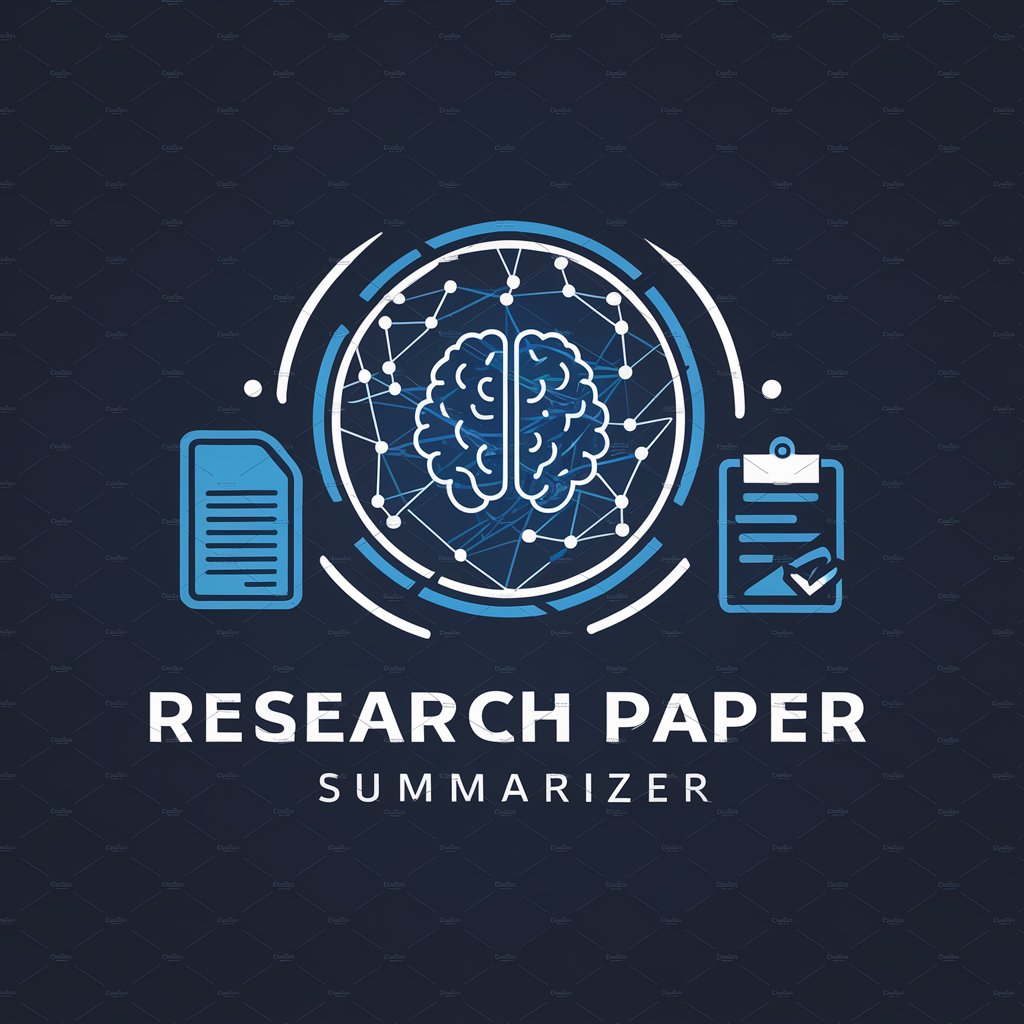
Research Paper Summarizer - Research Paper Analysis

Welcome to Research Paper Summarizer, your AI assistant for academic paper summaries.
AI-powered Research Insights
Summarize the key findings of the paper titled
Provide a detailed overview of the dataset used in the study
Analyze the results section of the research paper
Explain the methodology and model employed in the paper
Get Embed Code
Overview of Research Paper Summarizer
Research Paper Summarizer is designed to streamline the review and analysis of academic research papers. Its core function is to extract key information from research papers and compile it into an organized summary table. This table includes columns for 'Year', 'Title', 'Model', 'Input', 'Dataset', 'Results', and 'Conclusion', providing a structured overview of each paper. For example, when a user uploads a research paper on machine learning, the summarizer will identify and fill in details such as the paper's publication year, the title, the machine learning models used, the type of data input, the datasets employed, the results achieved, and the final conclusions drawn by the authors. This process is designed to assist users in quickly understanding the essence and contributions of various research papers without needing to read each one in its entirety. Powered by ChatGPT-4o。

Key Functions and Applications
Summarization and Table Compilation
Example
Upon uploading a research paper on deep learning techniques for image recognition, the summarizer will create a summary table entry highlighting the paper's main contributions, the deep learning models discussed, the image datasets used, and the achieved accuracy rates.
Scenario
This function is particularly useful in academic literature reviews, where researchers need to synthesize information from multiple papers to identify trends, gaps, and opportunities for further research.
Cumulative Summary Table Update
Example
When a subsequent paper on natural language processing (NLP) for sentiment analysis is uploaded, the summarizer adds a new row to the existing summary table, detailing the NLP models, input data types, datasets, key findings, and conclusions without disrupting the initial entries.
Scenario
This is beneficial in ongoing research projects, allowing teams to continuously update their literature review tables as new studies are published or discovered.
Non-Research Document Identification
Example
If a user mistakenly uploads a non-research document, such as a news article or a commercial product brochure, the summarizer will notify the user, briefly describe the document type, and provide a concise summary.
Scenario
This helps users filter out irrelevant documents from their research corpus, ensuring that only pertinent academic literature is included in their review.
Target User Groups
Academic Researchers
Researchers engaged in literature reviews can use the summarizer to efficiently process large volumes of papers, quickly extract vital information, and maintain an organized record of the research landscape in their field.
Students
Students working on theses or term papers can leverage the summarizer to aid in their literature review process, helping them to easily compile and understand relevant studies, methodologies, and findings in their area of study.
R&D Teams in Industry
Research and development teams in industries such as pharmaceuticals, technology, and engineering can utilize the summarizer to keep abreast of the latest scientific developments, innovations, and competitive research that could inform and influence their project directions.

How to Use Research Paper Summarizer
1
Access the tool for a trial without any login requirement or the need for a ChatGPT Plus subscription by visiting yeschat.ai.
2
Upload the PDF file of the research paper you wish to summarize. Ensure the document is clear and in English for optimal summarization accuracy.
3
Specify any particular focus you have for the summary, such as model, dataset, results, or conclusions, to tailor the output to your needs.
4
Review the generated summary table that includes columns like 'Year', 'Title', 'Model', 'Input', 'Dataset', 'Results', and 'Conclusion'. For multiple documents, the table will update with each new addition.
5
Optionally, request the summary table to be converted into a downloadable .xlsx file for ease of access and further analysis.
Try other advanced and practical GPTs
Software Test - Manual Test Cases and BDD Scenario
Empower testing with AI-driven scenarios

Beauty Copywriter
Crafting Your Beauty Narrative, Powered by AI

Email Subject Line Pro
Craft Captivating Email Subject Lines

TikTok Ads Virtual Assistant
Optimize Ads with AI Insights

Teacher of the Blind
Empowering education for the visually impaired.

Elden Bling 💍
Master Elden Ring with AI Guidance

Tumbler Artisan
Craft Unique Tumbler Designs with AI

First Response Buyers Service
AI-powered personalized property inquiry responses.

Niagara Login Template Aid
Tailor your Niagara login, powered by AI

Virtual User Navigator
Navigate your digital tasks effortlessly with AI
Login Page | Start your conversation here
Unleash AI's potential - Engage effortlessly.

@Login - Social Login
Streamline Authentication with AI-Powered Social Login

Research Paper Summarizer Q&A
Can Research Paper Summarizer handle documents in languages other than English?
The tool is optimized for documents in English. Summarization accuracy for non-English documents may vary and is not guaranteed.
Is it possible to summarize multiple research papers in one session?
Yes, you can upload multiple research papers in a single session. The summarizer updates the summary table with each new paper, adding a comprehensive view of all documents reviewed.
How does the tool handle highly technical or niche research areas?
Research Paper Summarizer is designed to extract and summarize key information across a wide range of disciplines. However, the clarity and specificity of summaries may depend on the complexity and niche of the research area.
Can I use Research Paper Summarizer for non-research documents?
While primarily designed for research papers, the tool can provide summaries for non-research documents but will notify the user that it is not a research document and adjust the summary accordingly.
What is the best way to ensure high-quality summaries?
For best results, upload clear, well-structured research papers in English. Specify your summary focus to tailor the output, and review the document for any format issues before uploading.